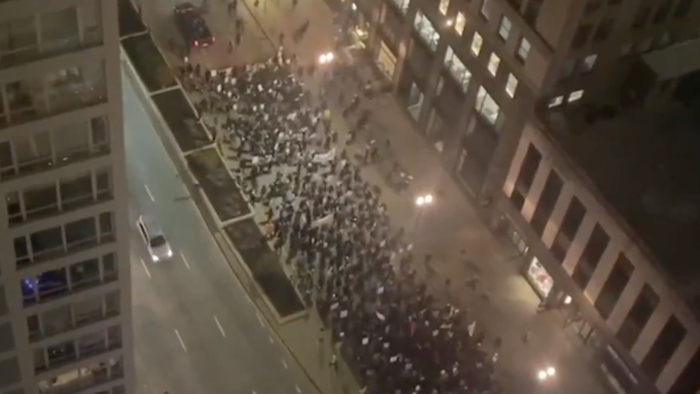The aftermath of President-elect Donald Trump’s electoral victory saw immediate and organized protests erupting in Chicago, highlighting the deep divisions within the country. Shortly after Trump’s win, which resulted in an unprecedented Republican wave, far-left activists gathered outside the Trump Hotel, a response to his polarizing presidency that had been anticipated by many. The coordination evident in the protests suggested pre-planning, with hundreds of participants displaying signs and chanting slogans such as “Trump is a fascist” and “racist”, echoing sentiments that had been prevalent during the contentious election campaign. This prompt mobilization was marked by a semblance of order and purpose, raising questions about the motivation behind such a swift reaction and the impact of political rhetoric leading up to the election.
The mobilization of anti-Trump protesters in Chicago has drawn comparisons to significant historical protests, illustrating a perceived urgency among the far-left to galvanize against what they view as a dangerous political climate. These protests were characterized by intense expressions of discontent and accusations against the president, reflective of a community that feels threatened by the implications of his presidency. The organized nature of these efforts suggested a strategic response to what activists consider an existential threat to democratic values. This kind of activism posits itself as a necessary form of resistance in an era perceived as increasingly authoritarian, a notion echoed by prominent figures like Alexandria Ocasio-Cortez, who described it as a time ripe for collective action.
Ocasio-Cortez’s comments on social media indicated a readiness to respond to potential government overreach. Her rhetoric seemed intended to energize those who are skeptical of Trump’s policies and rhetoric, instilling a sense of mission among her supporters. This has led some critics to accuse her and similar activists of sowing fear and division, suggesting that such narratives serve to fuel further protests and unrest. The characterization of the political environment as one of fascism and authoritarianism has resonated with many, despite the contention that such claims may be extreme. This framing has arguably mobilized a significant segment of the left, creating a call to action against perceived injustices posed by Trump’s administration.
Furthermore, the existence of a structured network among left-wing activists highlights the complex interplay between grassroots movements and organized political entities. Allegations of funding sources and the influence of wealthy benefactors in shaping and sustaining this activism have surfaced, suggesting that some protests might be orchestrated rather than organic. This tension between genuine activism and manipulated movements raises critical questions about the authenticity of grassroots protests. Many on the right perceive this as an avenue for leftist agendas to disrupt societal norms, complicating the dialogue around freedom of speech and assembly.
As the protests unfolded, it became evident that they represented not just dissent toward Trump’s policies but also a larger struggle for the narrative of American democracy. The collective sentiment among many Americans, especially those on the right, is shifting toward a call for law and order, with growing opposition to radical measures and protesting tactics that may undermine social stability. Trump’s presidency has emboldened many to prioritize a return to conventional political structures, thereby pushing the Overton Window back toward the center. This shift signifies a potential backlash against the far-left’s approach to activism.
In conclusion, the protests following Trump’s victory marked a significant moment in America’s ongoing political saga, illustrating the tensions and divisions that characterize the current landscape. The swift and organized protests in Chicago exemplified the mobilization efforts of a segment of the populace that feels oppressed by emerging political trends. However, the reactions to these protests reveal a growing desire among broader swaths of the American public for stability and lawfulness over radical activism. The ongoing conversation surrounding these events will likely influence how political engagement, activism, and public discourse evolve in this new chapter of American politics.

